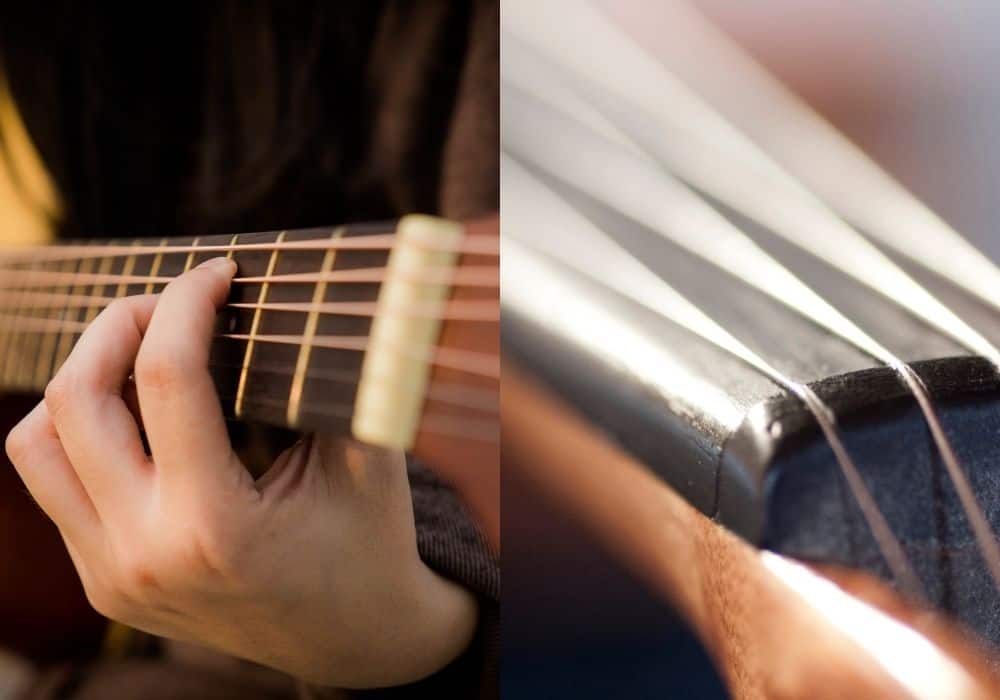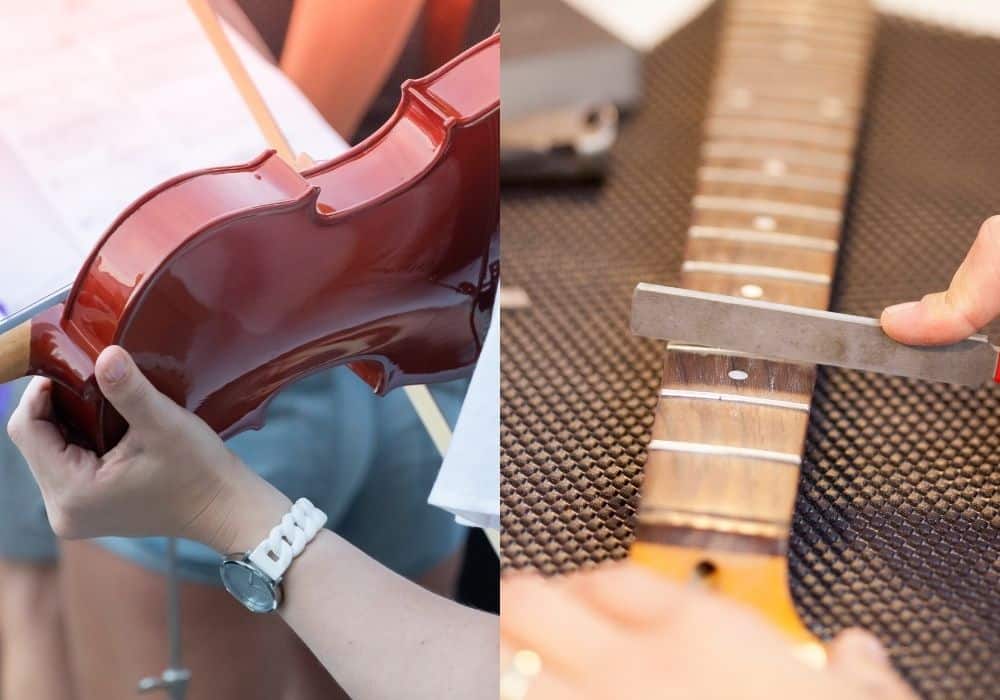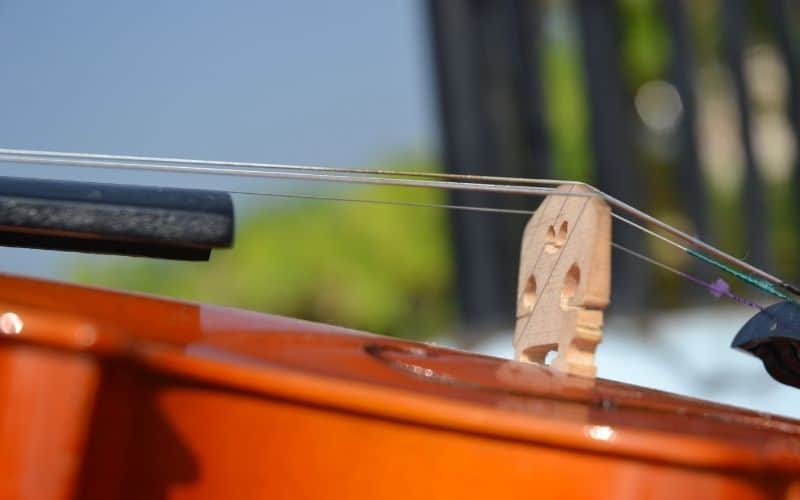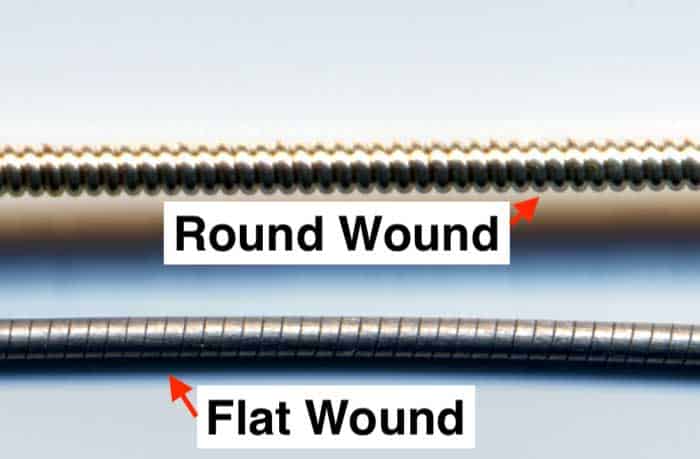Stringed instruments – or chordophones as they’re called – come in all shapes and sizes. Some instruments have four or six strings, while others have many multiples of strings.
It’s true that chordophones all use strings in some way or another, but the way they’re wound, the size, material, and even how they’re tuned can be drastically different. One example is the difference between guitar and violin strings; many ask if they’re the same.
Guitar and violin strings are not the same at all, in fact, they differ from each other in both size and material. Guitar strings tend to be thinner and longer than violin strings, have different pitches as a result, and violin strings are usually flat wound rather than round wound.
As it was already noted above, just like the instruments themselves, the strings all come in different sizes and shapes, including the packaging which are are curated for the instrument specifically. To an untrained eye, they may look the same, but they’re not interchangeable on different instruments. For example, if you tried to put violin strings on a guitar, you’d quickly realize your mistake.
How are Guitar Strings and Violin Strings Different from Each Other?

You can find a few YouTube videos demonstrating what happens when you put guitar strings on a violin, like this one for example.
You’ll notice a few things like the guitar strings do not fit the violin’s shorter neck, also, the guitar strings are simply wound too tight which puts too much tension on the violin. Another difference is they’re not tuned the same either.
In the past, both violin and guitar strings were made of either wire or gut (called “catgut” although they were almost always made out of sheep intestines in reality).
Modern-day guitar stings are now separated into two basic types – steel and nylon. Steel is generally used on electric and acoustic guitars. Nylon is typically found on classical and flamenco guitars.
Violin strings also got their start from sheep intestines up until the late 1800s. Still today, some high-end violin strings like Pirastros are made this way and they tend to be very expensive and used more in concert violins because players of this sort appreciate their warmth and tone.
Today, violin strings can be found in three general categories; gut, steel core, and synthetic core.
A violinist picks their strings based on the style they’re playing. One could probably argue that a big part of why certain violinists like the traditional gut strings has to do with nostalgia.
In other words, a classical approach sounds pleasing with gut strings because that is the tone from that era and there’s certainly an element of coolness there, a call-back to the past.
1) The Guitar and Violin Strings are Set Up Differently

Of course, there are some similarities between violin and guitars – after-all, they are both chordophones. Guitar and violin strings are designed to be tuned to concert pitch.
They can only be tightened a little higher than concert pitch before they risk breaking. When you string a guitar or violin you want to string them one at a time to keep even tension on the neck while adding on the other strings.
You can expect that by the time you string the last string that the pitch will go down on the first string you put on.
This is a similarity seen in nearly all stringed instruments, however. they are tuned differently. Guitar strings are set up in 4ths or Perfect 4ths, for example, the interval between C and F is called a Perfect 4th.
This is the case for the entirety of the guitar with the exception of the B string, which is set up as a Major 3rd from the G string. Starting on the low E string, the standard tuning is E, A, D, G, B, and then high E.
While guitars are 90% tuned as perfect 4ths, the violin, on the other hand, is tuned in perfect 5ths.
So you have G as the lowest string, then D, A, and E. One interesting fact is that the order in which the strings are set up is the same as a traditional bass guitar, but the other way around. So the low G string on the violin is in the same position as the low E string on the bass guitar.
2) Violin Strings are Much Thicker Than Guitar Strings

Below you will find the differences in the gauges of violin and guitar strings. The violin strings are much thicker, as you can see by the higher gauge number.
Thicker gauged strings are much better at playing lower notes than thinner gauged strings because there is a lot more mass which means they vibrate slower. A slower vibration means a lower pitch.
The pitch of the note produced by a guitar or violin string depends on three things: tension, length, and its mass. Increasing the diameter and weight of the string also increases its mass.
If two strings at the same length are placed at equal tension, the one with the greatest mass will vibrate slower and produce a lower frequency. In other words, the one that is thicker will play lower notes.
Violin – Equal Tension – Common Light Gauge Strings
Light gauge strings like Prelude’s from D’Addario commonly look like what you can see below. Although, it’s more normal for violin strings to be identified by their tension, rather than their gauge as is normally the case with guitar strings.
Nylon guitar and violin strings are similar in this regard, as you’d know if you’ve read my article on the differences between nylon and other strings in terms of playability.
| String Name | String Gauge |
| G | 0.066 (1.70mm) |
| D | 0.044 (1.14mm) |
| A | 0.029 (0.76mm) |
| E | 0.019 (0.50mm) |
Guitar Strings – Common Light Gauge Strings
0.010 to 0.046 gauge strings are easily some of the most popular. While there are speciality strings that could go thicker or thinner, the most common guitar strings you’ll find in a shop go from 0.009’s to 0.012s (the high e-string).
| String Name | String Gauge |
| E | 0.046 (1.16mm) |
| A | 0.036 (0.91mm) |
| D | 0.026 (0.66mm) |
| G | 0.017 (0.43mm) |
| B | 0.013 (0.33mm) |
| E | 0.010 (0.25mm) |
3) Guitar Strings Are A Lot Longer than Violin Strings – Resulting in Different Pitches

Guitar strings are nearly twice as long as violin strings, making the guitar string resonate about an octave lower than the violin’s string at standard length. A violin string’s length is anywhere from 8 1/2 inches to 13 inches, depending on the violin’s scale.
A typical guitar uses a guitar string with a scale length of about 24 to 25 1/2 inches. Though longer than needed, you would physically be able to string a violin with guitar strings, but not vice versa.
Stringing a partial set of guitar strings won’t make your violin sound amazing either. You may be able to curate your own set using similar gauges, but they won’t be able to keep tuned to perfect 5ths, the way a violin is supposed to be tuned.
Instead, you will be left with strings that will easily slip out of tune because, ultimately, the scale length of the violin produces a different amount of tension.
4) Guitar Strings are Usually Round Wound, and Violin Strings are Often Flat Wound

Guitar and violin strings are made from similar materials, but how they’re put together plays a significant role in how they resonate, and therefore how they sound as well. A flat wound string will eliminate “finger squeak” – the noise produced by the players’ fingertips sliding along the strings.
Round wounds, on the other hand, are more suited for better tone and more volume. When these strings are new, they give off a clear ring that is suitable for both acoustic and electric guitars.
A hybrid of the flat wound and round wound, the ground wound, is made the same way as round wound strings are made, but the winding is then ground down and polished so that the protrusions are removed, and a flatted surface remains. They keep the bright tone of the round wound with the smoothness of the flat wounds.
If you’ve ever taken a look at the thicker strings on a guitar, From E to D, you’ll notice they have ridges. The ridged appearance is caused by winding circular-round wires of nickel, chromium, phosphor bronze, or steel around core-steel round wires, making it a “round wound” string.
If used for an acoustic, the manufacturers typically use more acoustically resonant materials as well for more vibrancy (I’ve explained this before).
The violin uses a flat wound, or flat steel, wound around the inner round wire or wires, but because the outer material is shaped like a long, flat rectangle, it levels out the surface area, and it is called a “flat wound” string.
They’re made this way for a very specific reason: using a bow on round wound strings will damage both the bow and the strings.
Guitar strings are not like violin strings, as you can tell. The differences in length, material, and gauges make it very hard to interchange the strings on either instrument.
Due to differences in parameters like length, tension, and mass, producing the same tone on a violin with guitar strings won’t be as easy as you think.
It gets even worse if you try it the other way around, because you won’t be able to put violin strings on a guitar because of the difference in scale length. In other words, you won’t be able to find violin strings long enough to fit on a guitar.
With all this in consideration, it should be abundantly clear to you that guitar and violin strings are very different and they’re not interchangeable at all.

 Written By :
Written By :